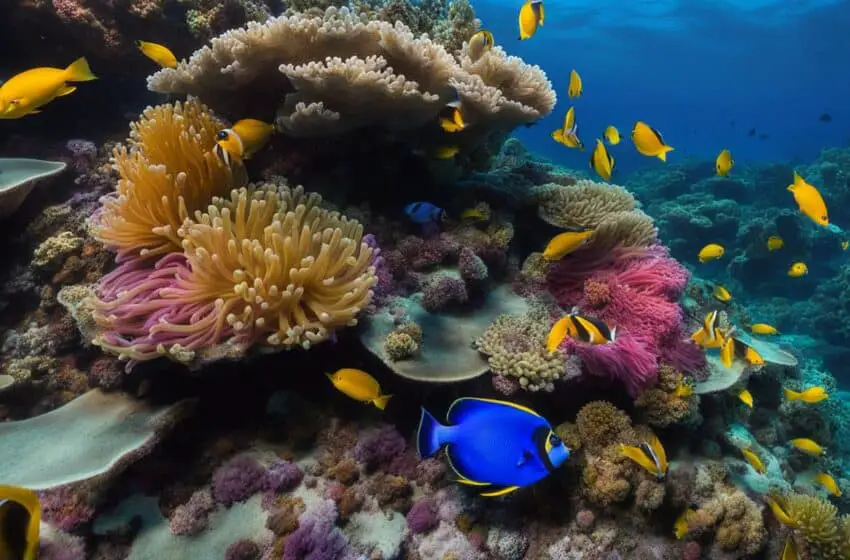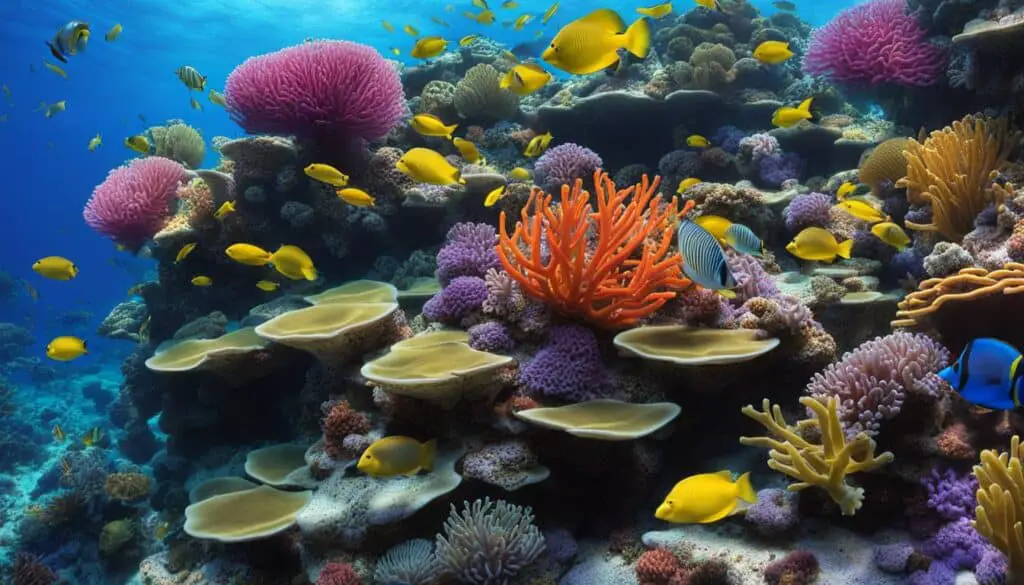Anemone Reef: Diverse Ecosystem, Conservation, and Wonders

Anemone Reef Conservation Marine Biodiversity: The remarkable anemone reef ecosystems highlight the significance and beauty of coral reefs. Divers and scholars alike are enthralled with these underwater worlds due to their vivid hues and rich marine life. This article explores the wonders of the anemone reef, emphasizing the importance of conservation efforts to preserve its delicate environment and its biological relevance.
The vibrant underwater environment of Anemone Reef, which is situated in the Andaman Sea, is well-known for its profusion of anemones and diverse marine life. Many amazing animals can be seen living on the reef, such as moray eels, barracuda, clownfish, and turtles. Divers and nature lovers should not miss it because of its amazing beauty and abundant biodiversity.
Key Takeaways:
- Anemone Reef has many types of sea creatures and pretty colors.
- We need to conserve it because it’s delicate.
- It’s in the Andaman Sea and people like to dive there.
- We have to take care of the reef so that the coral and sea life don’t get damaged.
- If you visit Anemone Reef, you can see how different creatures work together.
Anemone Reef: An Underwater Paradise
Anemone Reef, also known as “Hin Jom” in Thai, is a mesmerizing underwater habitat that captivates divers from around the world. Located in the Andaman Sea, this reef is a vibrant and diverse ecosystem teeming with marine life. It starts at depths of 3 to 5 meters and gradually descends to 25 meters, providing a range of habitats for different species.

The large groups of anemones that live on the rocks in Anemone Reef are what make it so beautiful. Many different kinds of sea creatures can hide and be safe in these anemones, which makes the ecosystem alive and linked. Divers can see clown fish dancing for fun, groupers swimming majestically, and seahorses moving gracefully among the swaying stalks of anemones.
This underwater paradise also does important things for the coral reef environment. Marine life is healthier and more diverse when there are habitats beneath that are thriving. These habitats are very important for keeping the sensitive balance of the ocean ecosystem because they provide food, shelter, and a place for young fish to grow up.
Diverse Marine Life at Anemone Reef
Anemone Reef is a great example of the diverse marine life that can be found in coral reefs. Each species plays an important role in maintaining the anemone’s complicated web of life, from the iconic clownfish that seek sanctuary in its embrace to the secretive moray eels that hide within the cracks. Larger creatures, such barracuda and turtles, are drawn to the reef because of its beauty.
Let’s take a closer look at some of Anemone Reef’s fascinating inhabitants so you can get a feel for the reef’s rich marine life:
| Marine Species | Description |
|---|---|
| Clownfish | These colorful fish form symbiotic relationships with anemones, finding protection and food amidst the anemone tentacles. |
| Grouper | Known for their size and bold patterns, groupers are predators that play a crucial role in controlling the reef’s ecosystem. |
| Seahorses | These delicate creatures are masters of camouflage, blending perfectly with the surrounding anemones and seagrass beds. |
| Moray Eels | With their serpentine appearance, moray eels are a fascinating sight. They dwell within the reef’s crevices, waiting for their next meal. |
Exploring the wonders of Anemone Reef is an unforgettable experience that reveals the beauty and complexity of our underwater world. As divers venture into its depths, they gain a deeper appreciation for the delicate balance that sustains this extraordinary underwater paradise.
The Fascinating World of Sea Anemones
Once upon a time, in the magical depths of the ocean, there lived a group of enchanting creatures called sea anemones. These whimsical beings resembled delicate flowers, with their soft, cylindrical bodies and vibrant colors that sparkled like jewels under the sea.
Each sea anemone had a special power – the ability to capture their prey with their venomous tentacles. They used their stinging powers to immobilize their prey, like a magician casting a spell on their victim. But despite their deadly powers, these creatures were still beloved by many in the underwater world.
One day, a group of adventurous clownfish stumbled upon a group of sea anemones. The clownfish were in awe of the sea anemones’ beauty and grace, and they soon struck up a magical friendship. The clownfish would swim playfully around the sea anemones, and the anemones would bask in the glow of their new friends.
The sea anemones were so enchanted by the clownfish that they decided to invite them to live with them in their underwater kingdom. The clownfish happily accepted the invitation, and soon they were swimming and playing together every day.
As time went on, the sea anemones and the clownfish became inseparable. The anemones provided a safe haven for the clownfish to hide from predators, and the clownfish brought nutrients and food to the anemones. Their symbiotic relationship was a testament to the beauty and harmony of nature, and it enchanted all who witnessed it.
And so, the sea anemones and the clownfish lived happily ever after, their magical friendship a shining example of the wonders that lay beneath the ocean waves.
The Diversity of Sea Anemones
There are a lot of beautiful shapes, sizes, and colors of sea anemones. Some species live alone, but others live in groups that make beautiful aquatic gardens. These amazing animals are very important to coastal communities and help keep the ocean healthy and full of different kinds of life. Not only are sea anemones beautiful to look at, but they can also tell you a lot about the health of the area they live in.
| Species | Description |
|---|---|
| Carpet Anemone (Stichodactyla gigantea) | Large and vibrant anemone found in the Indo-Pacific region. Known for its symbiotic relationship with anemonefish. |
| Beadlet Anemone (Actinia equina) | Commonly found in rocky shorelines of the North Atlantic. Exhibits a range of colors, including green, red, and brown. |
| Tube Anemone (Cerianthus spp.) | Burrows itself in sandy or muddy areas, with only its tentacles visible. Comes in various colors and can reach impressive lengths. |
Sea anemones are amazing creatures. They have bright colors and help keep our oceans healthy. They have important relationships with other sea life. Seeing them reminds us of how important it is to protect marine life.
Conclusion
Anemone reefs are beautiful and important for the environment. They have many colors and creatures living in them, and these relationships are interesting to study. Protecting these reefs is crucial to maintain their anemone reef Conservation Marine Biodiversity fragile nature and marine life. We can do this by using practices to manage them. This way, we can keep the beauty and value of Anemone Reef and coral reefs for future generations.
FAQ
What is Anemone Reef?
Anemone Reef, also known as “Hin Jom” in Thai, is a vibrant and diverse marine ecosystem located in the Andaman Sea. It is fully submerged beneath the sea’s surface and is known for its abundance of anemones and colorful marine life.
What marine creatures can be found at Anemone Reef?
Anemone Reef is home to a variety of marine life including clown fish, anemone fish, porcelain crabs, snapper, barracuda, whale sharks, leopard sharks, groupers, turtles, cuttlefish, seahorses, sea snakes, scorpion fish, and moray eels.
Why is Anemone Reef a must-visit for divers?
The stunning colors and diverse marine life make Anemone Reef a popular destination for divers. Exploring this ecosystem allows divers to witness the beauty and richness of underwater life.
How deep is Anemone Reef?
Anemone Reef starts at depths of 3 to 5 meters and gradually descends to 25 meters, providing a range of depths for divers to explore.
What are sea anemones?
Sea anemones are invertebrates that resemble corals and jellies. They have a soft, cylindrical body with venomous tentacles and form symbiotic relationships with other animals.
How many species of sea anemones are there?
There are more than 1,000 species of sea anemones found worldwide in various marine habitats.
How do sea anemones feed?
Sea anemones feed on plankton and fish using their stinging tentacles. They have a single opening for food intake and waste expulsion.
Why is conservation important for Anemone Reef?
Conservation efforts are crucial to protect the fragile nature of Anemone Reef and preserve its biodiversity and ecological importance for future generations.
How can we promote sustainable reef management?
By implementing sustainable reef management practices, we can ensure the long-term survival of coral reef ecosystems like Anemone Reef and protect marine biodiversity.



